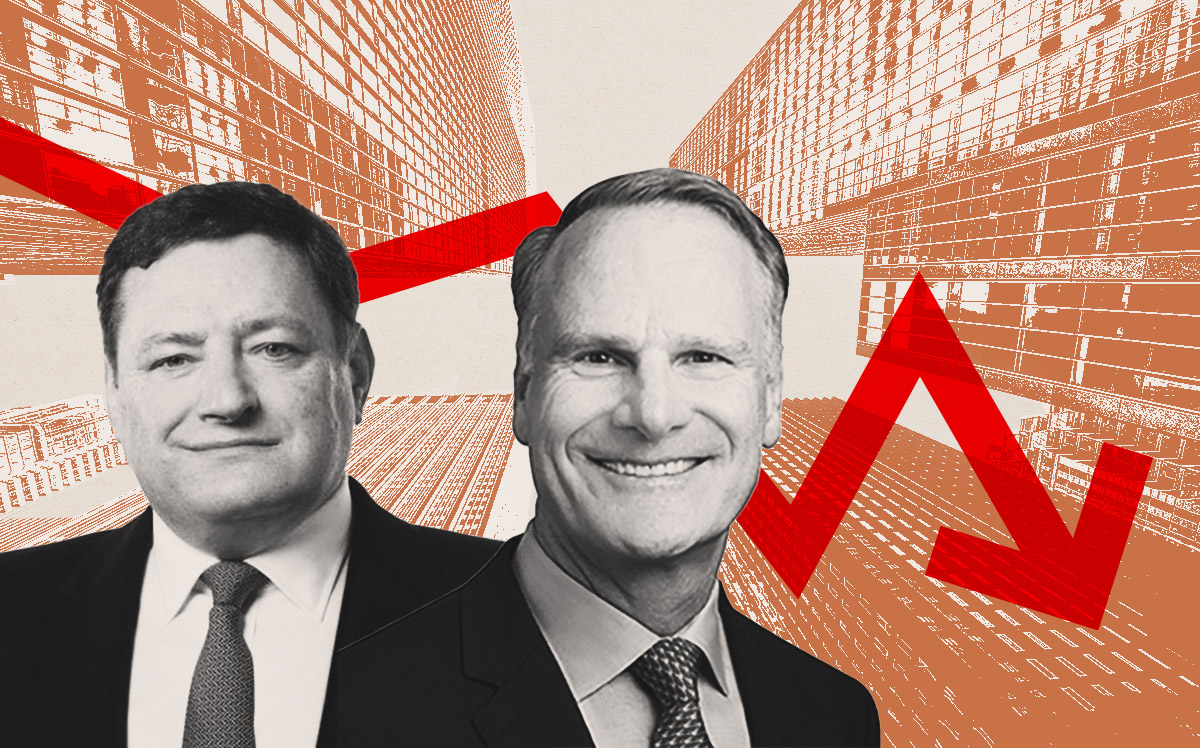As Cushman & Wakefield prepares for one of the most challenging years in its 100-year history, the company is facing a crisis of confidence.
There’s been a revolving door at the CEO spot in recent years, and people both inside and outside the company say it lacks a clear sense of leadership.
TPG, the private equity firm that took Cushman public six years ago, sold its largest block of shares late last year when the stock was at rock bottom — leaving the impression that the company has lost faith in its investment.
Short sellers have piled onto Cushman stock, competitors have picked off top producers, S&P cut its credit rating and the company’s made some high-profile blunders that raise questions about its leaders’ judgment.
The most significant of Cushman & Wakefield’s challenges stem from the $3 billion debt load TPG piled onto the company ahead of its IPO in 2018. As the company focuses on cutting costs, there are concerns it’s losing ground to competitors like CBRE and JLL that are in a better position to ride out the slow CRE market and then capitalize when it eventually recovers.
“Under CEO Michelle MacKay’s leadership, we have refined our strategy and strengthened our balance sheet to capitalize on the opportunities ahead,” Cushman spokesperson Brad Kreiger wrote in an email. “Through this cycle, we have continued to win complex mandates from the world’s largest organizations, recruited top talent from across the industry and delivered for our clients through the specialized expertise of our more than 52,000 people globally.”
No one believes Cushman is on the path to financial ruin, but its grand ambition of becoming the third global CRE-services powerhouse has not materialized, at least from a shareholder’s perspective. The stock, which IPO’d at $17 a share, currently trades at about $10.
Part of the company’s strategy to de-lever is looking to sell some of its ancillary business lines. Executives have been in talks to sell its building-maintenance business C&W Services and its stake in its China property-services joint venture with the Chinese developer Vanke, according to people familiar with the negotiations.
Meanwhile, it’s been a mixed bag for the brokerages that have already reported performance.
Colliers last week reported fourth-quarter earnings of $198 million were down 2 percent from the same time last year, and CBRE on Thursday said its fourth-quarter earnings rose a little over 10 percent to $737 million.
Cushman will report its earnings on Tuesday, and observers are expecting it won’t be pretty.
“[Michelle] MacKay and her CFO are probably sitting in a room now trying to figure out how to tell the bad story,” one former company executive said.
A C-suite carousel
A little more than two years ago Brett White, whom TPG hand-picked to take Cushman public, stepped down as CEO and handed over the reins to longtime company veteran John Forrester.
Forrester lasted just about a year.
Last spring, he announced his resignation and was succeeded by company president Michelle MacKay — a move that signaled a shift in company strategy toward the balance sheet.
Forrester had come up through the company over a 35-year career (he started at Cushman predecessor DTZ in 1988) and was seen as a broker’s CEO who understood the business from the perspective of the rank-and-file. MacKay, on the other hand, was seen as a brokerage outsider: She had worked earlier in her career in the real estate departments of JPMorgan and UBS, before spending 15 years at the ground-lease REIT iStar.
But whereas Forrester was known for his rah-rah style of traveling to regional offices and rallying the troops, MacKay spends most of her time in the New York office, according to sources.
Some high-ranking employees say they’ve yet to see her in person, and others question who’s really in charge — whether it’s the CEO, the board, the largest shareholders or the banks lending to the company.
“Everyone is wondering who is pulling her strings,” one Cushman broker said, noting that TPG has been selling down its position and is no longer the largest shareholder.
Even when Forrester was CEO there were whispers that White, who retained his position as executive chairman, was actually calling the shots. But it looks as though his role is diminishing. White took a job as CEO of Michael Meldman’s Arizona-based development firm Discovery Land Company in January 2022 and has seen his Cushman compensation reduced.
White will earn $480,000 this year as executive chairman of the board, according to an offer letter Cushman filed with the Securities and Exchange Commission. In 2022 he received $10.6 million in stock awards and other compensation.
The C-suite instability comes at a time when ownership is in transition.
TPG sold 10 million of its C&W shares in November at $7.63 — roughly the lowest the stock’s been since it went public. TPG had been Cushman’s largest shareholder and is now second behind the behemoth investment manager Vanguard Group.
A TPG spokesperson said the company has gradually sold down its interest in Cushman over the last 5 years “consistent with our investment horizon and duty to return capital to our investors.”
“We have partnered with the Cushman & Wakefield team for a decade, supporting the company most recently as a minority shareholder since 2019 and always focusing on the long-term success of the business,” the spokesperson said. “We continue to believe in and support the business.”
It’s yet another chapter for Cushman, which has been handed off from one owner to another over the decades. Founded in New York in 1917, the company was acquired in 1969 by RCA Group, which sold it to the Rockefeller Group in 1976. The Italian Agnelli family (founders of the Fiat motor company) acquired control in 2007 and then sold the company to TPG’s group in 2015.
“You can’t have that many owners and have the same philosophies about growth,” a brokerage executive at a competing firm said.
Balancing act
One of MacKay’s first moves after taking over was to extend the company’s debt maturities. But the financial flexibility came at a price.
In August Cushman issued $400 million of senior notes due 2031 at a rate of 8.875 percent — up from the 6.75 percent the company pays on notes issued in 2020. It also closed a new $1 billion term loan facility with a maturity date of 2030 and an interest rate of SOFR plus 4 percent.
That’s more expensive than the previous term loan, which had an interest rate of 2.75 percent over the now phased-out LIBOR index. So while it’s true that debt costs are going up as a result of rising interest rates, lenders are also charging a larger spread for the perceived risk.
In January, S&P cut Cushman’s credit rating from BB to BB-, citing concerns that the debt ratio could go as high as 6x during the first half of the year.
Moody’s in December affirmed its B1 rating of Cushman and revised its outlook down from positive to stable.
“That’s largely driven by the operating landscape for commercial real estate service companies,” Moody’s analyst Reed Valutas said. “Some of the softness as we’ve seen with softening credit conditions and the like have reversed their performance from an operating standpoint, given the challenging background CRE landscape, so we brought the outlook back to stable.”
Some investors have taken a skeptical view. Short sellers piled onto the stock last year, pushing the short interest at one point up over 11 percent. Though that number has since come down to 6.79 percent at the end of January, Cushman is still the most-shorted stock among the big CRE brokerages.
MacKay said on the October earnings call that the company wants to strike a balance between paying down debt while growing the company.
“So we want to both be reducing debt and investing in growth, right? This is not an either/or conversation,” she said. “And I think what’s important for everybody to understand is that we’re committed to reducing our debt level over time as we grow the business because we believe this is the optimum path to generating strong shareholder returns.”
But some doubt the company can do both at once. Hunter Hopcroft, a portfolio manager at Armada ETF Advisors, wrote that he believes Cushman does have to prioritize one over the other.
“I believe it is, in fact, an ‘either/or’ proposition especially in the context of the changing brokerage landscape,” he wrote on his blog, explaining that Cushman and its competitors are trying to grow the parts of their businesses like building management that generate steady fees while revenue from brokerage transactions are down.
“The business must invest to grow, but its ability to do so is considerably constrained by the current state of the balance sheet,” he wrote.
Major miscues
It’s true that the CRE landscape has made it tough for everyone, but Cushman has made some blunders recently that make it seem like it just can’t get out of its own way.
Take, for instance, its investment in WeWork.
A few years ago all the big brokerages were getting into the flex-work space. CBRE in 2020 invested $200 million in Industrious and Newmark the following year acquired Knotel out of bankruptcy.
Cushman felt pressure to keep up, observers said, and the company invested $150 million into WeWork in October 2021 — a time when there were already plenty of red flags around the struggling company.
It turned out to be a costly mistake: WeWork filed for bankruptcy last November, and as of late September Cushman had written its investment in the company down to $1.1 million.
“The investment as a whole — we’ve already taken the mark-to-market there,” CFO Neil Johnston said on the October earnings call, shortly before WeWork filed for Chapter 11 protection.
In another high-profile miscalculation, the company fumbled a deal that ruined a relationship with an important client.
Cushman had been in talks to relocate its Manhattan office on Sixth Avenue to Brookfield’s redevelopment at 660 Fifth Avenue. Cushman negotiated the lease right up until the last minute before abruptly walking away, according to sources — a move that enraged Brookfield.
Brookfield retaliated by firing Cushman from all its leasing assignments. Rubbing salt in the wound, a few weeks later Brookfield signed a coveted property management contract with Cushman rival CBRE.
A Cushman spokesperson at the time said, “While completely surprised by this reaction, we consider disciplined management in the best interest of our firm, employees and shareholders.”
The company has also lost some major talent, as sources said it’s struggled to match offers from competitors targeting its dealmakers.
Its New York City sales office has been decimated since its top brokerage team led by Doug Harmon and Adam Spies left for Newmark last February. Newmark came back again toward the end of the year and poached another group led by Dan O’Brien.
Barry Gosin’s Newmark, flush with an $850 million cash infusion the company received in 2021, has taken a countercyclical point of view and invested heavily in the downturn while others have pulled back.
His company in April hired a team of Cushman leasing brokers on Long Island, and in November poached a team of life-science brokers in Los Angeles.
Cushman’s also parted ways with some important leaders: Carlo Barel di Sant’Albano, the global CEO of capital markets who had been with the company for more than a decade, left in March. And in November Cushman let go of its head of L.A. capital markets, Phil Brodkin, amid cost-cutting measures.
Cushman has to tread carefully now, with the perception that it’s a company moving backwards.
Tod Lickerman, the firm’s former global president and Americas CEO, said the company is de-levering at the most difficult time. And it may be cutting back in a way that will prevent it from growing when the market recovers.
“I’m not sure cost cutting and selling assets is going to solve higher leverage ratios,” he said. “Ultimately you have to grow earnings and that will come with the recovery.”
Elizabeth Cryan, Keith Larsen and Sam Lounsberry contributed reporting.
Read more



